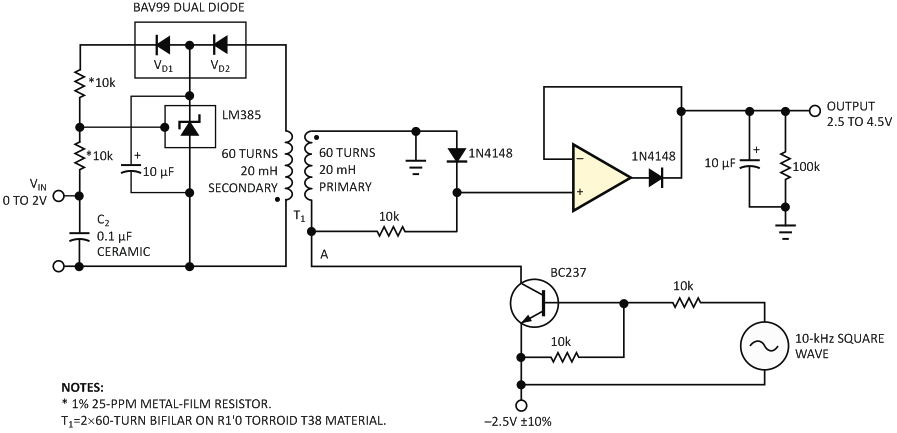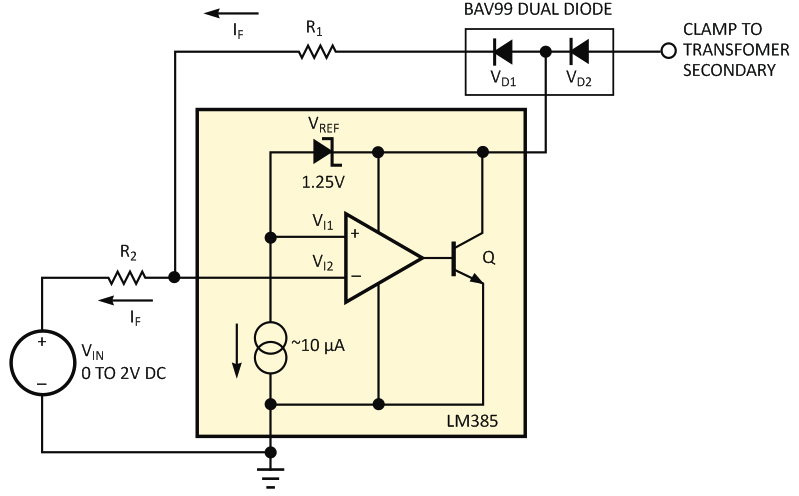Andrew Russell
EDN
The circuit in Figure 1a is a low-cost isolation amplifier for instrumentation applications that provides as much as 500 V of galvanic isolation between input and output. The amplifier uses only one small, low-cost transformer and with little modification lends itself to cost-effective multichannel applications. Input-to-output linearity is around 0.05% for a 2 V input signal. The LM385 (Texas Instruments) low-power programmable reference diode, which operates in the shunt mode, and the dual planar BAV99 (NXP Semiconductors) diode are the major circuit components.
To understand the circuit's operation, you have to first look at the clamp circuit (Figure 1b). The LM385 is a shunt regulator that consists of a control amplifier, a current-shunt transistor, and an internal precision 1.25 V reference. Two external feedback resistors, R1 and R2, set the output voltage. In conventional LM385 applications, the collector of Q is the clamp, or current shunt point. However, in this design, the clamp has to include dc blocking, which VD2 provides because the circuit feeds VD2 with an ac signal from the transformer secondary. VD1, which is inside the LM385 feedback loop, compensates for VD2. Because VD1 and VD2 are thermally coupled inside a single package, changes in the forward voltage drop across VD2 due to temperature are mirrored across VD1. The transfer function of the clamp circuit is VCL = 2VREF + VIN.
In the overall circuit, a symmetrical, 10-kHz square wave drives a low-cost BC237 npn transistor, which in turn drives the primary of T1. In the forward mode, no secondary current flows due to the dc blocking action of VD2. During this phase, primary magnetizing current, which the circuit converts to magnetic field energy, ramps from 0 to –650 µA. When the BC237 turns off due to the drive voltage on its base switching low, the inductive energy in the core dumps into the secondary, causing VD2 to be forward-biased and current to flow through the LM385 and back to the other side of the secondary winding. The anode voltage of the LM385 clamps at precisely VIN + 2VREF – VD1. However, the addition of VD2 into the clamp voltage at the anode of VD2 compensates for VD1, resulting in a clamp voltage of 2VREF + VIN. Note that the voltage drop across the diodes during clamping is different due to the large discrepancy in current between the two diodes; VD2 carries the peak clamp current, and VD1 conducts only the feedback current. However, the circuit largely compensates for the temperature-induced changes in forward voltage drop, which can be a major source of error. Although some mismatch in the thermal tracking of the diodes does occur due to the different forward currents in the diodes, this mismatch is small enough given the accuracies of the circuit that you can consider it a second-order effect.
The response time of the circuit at Point A is less than 3 msec for 10 to 90% and 90 to 10% input-signal steps. Note that the input signal must be capable of sinking the feedback current, IF, which for the values in the circuit is approximately 65 µA. With 100-kΩ feedback resistors, the feedback current drops to approximately 8 µA. Drift is largely a function of feedback-resistor stability, LM385 temperature stability, and the thermal tracking of the diodes within the dual-diode package. Average current consumption of the circuit, excluding the peak-detector op amp, is approximately 150 µA. The noise and stability of the –2.5 V supply that drives the transformer are not critical, and a simple zener regulator suffices. Figure 2 depicts the linearity performance as both a percentage of reading and as a percentage of full-scale.
 |
|
| Figure 2. | Linearity performance of the circuit is measurable in terms of percentage of reading and as a percentage of full scale. |
In multichannel-isolation applications, you can delete the peak detector stage and feed Point A, or the primary winding, directly into a high-speed, multichannel ADC. For a 10-kHz drive frequency, the clamped waveform tops are typically approximately 20 to 40 µsec long. Sampling should take place at some fixed time after the rising edge, such as 25 to 30 µsec, because the amount of current that shunts through the LM385 decreases during the clamping period as the magnetic energy in the core decays. The LM385 and the associated rectifier diode, VD2, have a dynamic resistance that depends on the current that each device is conducting. The secondary winding resistance times the clamp current also gives rise to a further error term. These two errors combine and are reflected as a slope on the clamped waveform tops appearing on the primary winding when you view the signal at Point A with a scope. For this reason, you need to sample this waveform at some fixed point after the rising edge of the clamped portion of the waveform. Otherwise, errors can result in the readings taken from one sampling event to the next.
In this design, slight overshoot on the rising edge is too fast to cause any problems on the peak detector, but this overshoot would cause a problem at the input to a high-speed ADC. Again, sampling at some fixed period after the rising edge will obviate any problems.
Note that the output clamp voltage measured at Point A varies from 2.5 to 4.5 V because of the initial 2.5 V offset that stems from the 2VREF term in the transfer equation. You have to remove this offset through a subsequent offset removal circuit or by simply subtracting the offset value from the reading in software when using a high-speed ADC. The use of software calibration techniques makes this a viable option in a production environment.
Materials on the topic


